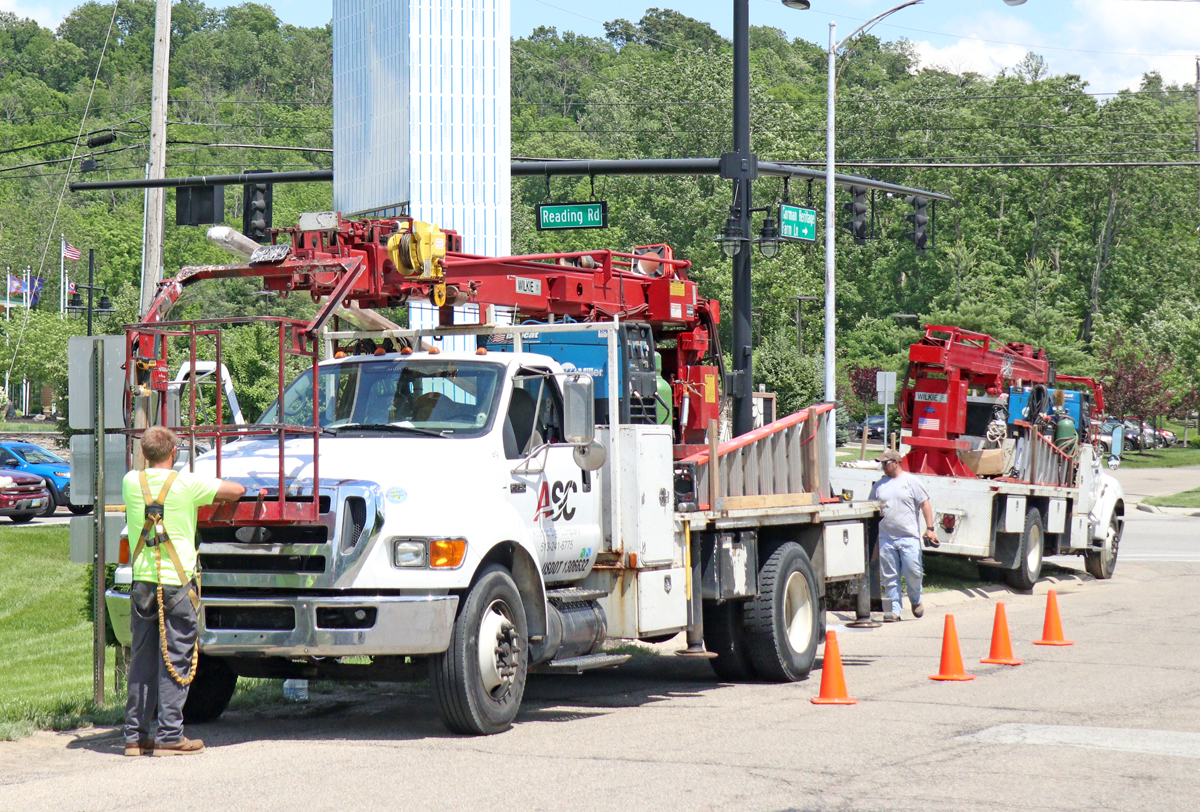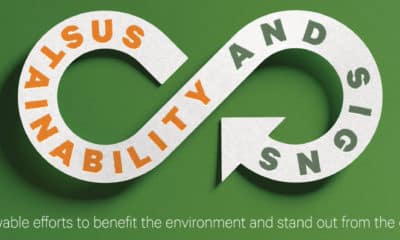Best Practices
Sign Installation Equipment
It starts, and could end, with the tie downs.
Published
7 years agoon

Some years ago, I was working in a shop that housed old, but functioning sheet-metal equipment, including an 8-ft. wide, hydraulic-driven sheet-metal shear, aka a guillotine. The rhino-sized shear was equipped with a Plexiglas® safety shield that protected the operator’s fingers from the cutting blade. Trouble was, the Plexi was old, yellowed and spider-webbed, which made it difficult to see scored cut lines on the sheet metal. The machine operator often beefed that he couldn’t see the cut lines and one day, saying he was sick of the damn plastic shield, he grabbed a Phillips-head screwdriver and removed it. “Damned nuisance anyway,” he said and promptly sliced off a finger.
Because geniuses abound, there is more – there is always more. Like, yesterday, on Interstate 75, a silver Nissan Frontier pickup truck passed me. It was carrying a Sears professional power washer in the bed. What brought my attention to the pickup wasn’t the bright red power washer, but the large black-and-white vinyl sign on the pickup tailgate. In 5-in.-high Helvetica letters, the sign said “DUMP O.S.H.A.”
It was then I noticed the power washer wasn’t tied down.
Is a “tie down” considered sign installation gear? You bet. Because, in a broad view, the principal sign installation tool is the truck that carries the sign to the site, or the crane truck that lifts the sign into place. Often one truck does both jobs. However, the least possible sphere of human attention is the tie down, the rigging that provides on-the-road cargo security inside the vehicle, its bed or its trailer. Thus, after trucks, tie downs are a critical installation component because they keep everything safely attached to the vehicle. I say inside and outside because a seat-side Walmart cooler filled with ice and Gatorade can easily weigh 25 lbs. and, during an accident, such hard-sided plastic globules easily transmogrify into a winged mass that can inflict considerable damage and intense pain.
Obviously, vehicle load items – cargo, or here, signs en route to installation – can be damaged in an accident and that’s a real liability, but cargo can also tear loose and become a launched cannonball – like the 75-lb., untethered power washer cited above. Imagine a crane truck welder becoming airborne during a high-speed crash. Now, imagine it hurtling across two lanes and into someone’s windshield.
Tie downs comprise ratchet straps, winch straps and belt straps in various widths and featuring metal hardware attachments. Other securing methods include bolting the sign directly to the truck or trailer bed, which limits excess vibration and flexing, but such methods should also include tie-down straps.
AdvertisementShock cord (bungee-cord-type material) is sold in rope-like lengths and the maximum ½ in.-diameter shock cord is advertised with a tensile strength of 450 lbs., which is good – for securing your tent in a Colorado chinook. But bungee cords aren’t tie downs, not for signs anyway. Besides, you’ll look silly in court, defending your shop’s use of bungee cords.
Also, I believe tie downs should be slightly stronger than required for the maximum effort job, just as an additional safety factor. Truck tie-down assemblies (strap and hardware) can rate up to 15,000 lbs., but be sure the attached hardware matches the strap or rigging tensile strength.
Of course, citizen pickup truck drivers aren’t required to comply with Federal Motor Carrier Safety Administration (FMCSA) cargo securement policies, but is your shop required to comply? And, even if not required, what is your shop and personal liability insurance coverage in an accident where the cargo itself causes the damage? Your vehicle insurance may not – probably does not – cover cargo, i.e., the sign you’re transporting and, even if it does, does your policy have liability coverage for cargo-caused damage?

JOINT TORTFEASORS
The legal term “tortfeasor” describes a person who has committed a wrongful act, a tort (i.e., a civil wrong), that injures another and for which the law provides a legal right for the wronged party to seek relief. More interesting for sign shops is the term “joint tortfeasor” because it speaks of two or more persons who owe another person the same duty and whose negligence results in injury to such other person, thus rendering the tortfeasor both jointly and severally (individually) liable for the injury; the parties must either act in concert or must by independent acts unite in causing a single injury.
In plain English, it says all who are involved – meaning having acted in concert or having united in independent acts – can be sued, jointly and individually.
AdvertisementIn even plainer English, it’s saying everyone involved in loading and securing cargo, even those who are not present but providing the materials, can be named. It’s the same on a job site: If supervision, equipment or safety practices are lacking, everyone involved can be in court.
And, even if you’re exempt from FMCSA policies, would those rules act as a liability guide for the plaintiff in an accident? Negligence is the failure to exercise that degree of care which a person of ordinary prudence would exercise under similar circumstances. The law rates negligence in three categories: slight, ordinary and gross, and each relates to standards of protection for others against unreasonable risk.
TRUCKS AND TRAILERS
Schedule routine and frequent trailer inspections because many trailers are made in local shops that may or may not integrate reliable components – or employ a certified welder. We all know, for example, that trailer tires, brakes and bearings can become a roadside nightmare, thus routine inspection is important, but truck owners and drivers should also and routinely inspect the trailer framework and its welds. The ESAB Knowledge Center (esabna.com) recommends non-destructive, post-weld visual inspections that scan for undersized, undercut, underfilled and overlapping welds, each of which could become a joining problem. The firm also recommends searching welded joints for surface cracks, porosity, burn-through and under- or over-penetration. It also notes that excessive reinforcement put in place by the trailer manufacturer may indicate “corrections” for structural weaknesses.
KNOW THE RISKS
I telephoned psychologist Guy Richardson, an ex-Army medic and oil-field safety officer, to obtain his feedback on site safety. Without hesitation, Richardson said leadership’s attitude toward safety was paramount, but it needs to be accompanied by rigid safety policies. He also reminded me of the Vince Lombardi “This is a football” story in which the wizened and winning coach started each training season by reviewing the basics. See this as similar to proper tie-down straps, a basic but critical requirement. Richardson said Lombardi made sure everyone was on the same page, which is also important in safety practices. Richardson also noted the US Army safety practice of requiring the newest team member to ask the first question, because their freshness may cause them to see and mention things others consider routine. Finally, he suggested safety walkarounds each morning. He said, “Everyone should know of all risks and how to avoid them.”
Note that all crane and bucket trucks are equipped with warning stickers, those that say “Danger, Electrocution Hazard, Death or Serious Injury will result from contact with or inadequate clearance to electrical power lines or apparatus,” but it’s not uncommon to find such warnings glued in rarely inhabited areas, like on the front bumper. Such stickers need to occupy areas generally occupied by installers, those who tend to lean on or stand near the truck while waiting for the crane operator to place the sign. Unfortunately, one misplaced, high voltage contact can make those guys a shortcut to ground.
Put safety stickers where the workers are or might be, not on the truck bumpers.
AdvertisementPROXIMITY DETECTION SYSTEMS
You may read of proximity detection systems that warn crane operators of high voltage nearby, and such systems are a good idea, but I’ve noticed that some (many?) crane/electrical contacts occur during the setup, with the boom moving at a speed that creates kinetic energy that, amplified by the crane weight, is too clumsy to stop, even when the lines are spotted or alarms are buzzing.
Thus, the best installation and safety equipment comprises the people working the job.
The Washington State Department of Labor and Industries provides overhead power lines training and videos (lni.wa.gov/Safety/Topics/AtoZ/OverheadPowerLines/training.asp) which clearly remind that overhead lines carry high voltage and are not insulated. The safest actions, it says, are to ask the power company to de-energize the lines before you arrive and confirm that they do. If this isn’t possible, the driver should get out of the truck and survey the site, then place a crane spotter equipped with a communication system (phone, walkie-talkie, but not easily misunderstood hand signals) outside the truck. The website lists five prevention instructions that include meeting with crew in advance, reviewing safety procedures, designating a competent spotter, knowing the minimum approach distance (not less than 10 ft.) and posting safety signs to remind everyone of the hazards.
If such processes seem tortuous, weigh them against personally streaming 7,500 volts to ground.

SPONSORED VIDEO
Introducing the Sign Industry Podcast
The Sign Industry Podcast is a platform for every sign person out there — from the old-timers who bent neon and hand-lettered boats to those venturing into new technologies — we want to get their stories out for everyone to hear. Come join us and listen to stories, learn tricks or techniques, and get insights of what’s to come. We are the world’s second oldest profession. The folks who started the world’s oldest profession needed a sign.
You may like
Advertisement
Subscribe

Magazine
Get the most important news
and business ideas from Signsofthetimes Magazine.
Advertisement
Most Popular
-

 Tip Sheet3 days ago
Tip Sheet3 days agoAlways Brand Yourself and Wear Fewer Hats — Two of April’s Sign Tips
-

 Business Management1 week ago
Business Management1 week agoWhen Should Sign Companies Hire Salespeople or Fire Customers?
-

 Women in Signs2 weeks ago
Women in Signs2 weeks ago2024 Women in Signs Award Winners Excel in Diverse Roles
-

 Real Deal4 days ago
Real Deal4 days agoA Woman Sign Company Owner Confronts a Sexist Wholesaler
-

 Editor's Note1 week ago
Editor's Note1 week agoWhy We Still Need the Women in Signs Award
-

 Maggie Harlow2 weeks ago
Maggie Harlow2 weeks agoThe Surprising Value Complaints Bring to Your Sign Company
-

 Line Time2 weeks ago
Line Time2 weeks agoOne Less Thing to Do for Sign Customers
-

 Product Buying + Technology1 week ago
Product Buying + Technology1 week agoADA Signs and More Uses for Engraving Machines









